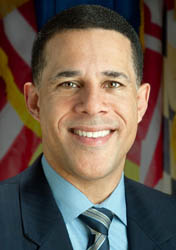Last month, I had the pleasure of joining Marylanders from across our state as the governor signed the Health Benefit Exchange Act of 2012 into law — continuing Maryland’s national leadership in the implementation of health care reform. We took the first step in this direction the day after President Barack Obama signed the Affordable Care Act by creating a bi-partisan council, which I co-chair, to examine the new federal law and make recommendations on how we could implement it most effectively.
Health care reform is not new to Maryland. Our efforts before the health law took effect included the expansion of Medicaid to provide care for over 315,000 of our most vulnerable children and families; allowing young adults to stay on their parents’ insurance until age 25; and providing seniors in the Medicare Part D “doughnut hole” with assistance to afford prescription medications. The ACA provided an unprecedented opportunity to build on these initiatives with the support, resources and leverage of a new partnership with the federal government.
Despite our progress, more than 700,000 Marylanders remain uninsured. The health law’s provisions, such as the establishment of health benefit exchanges, financial support in the form of grants, tax credits and cost-sharing subsidies, and a significant Medicaid expansion, offer states critical tools to make a real dent in these numbers. An independent expert analysis of our state projects that by 2020, full implementation of the ACA will enable us to cut the number of uninsured Marylanders in half.
To achieve its full potential, we believe that Maryland’s exchange must be an open, transparent and competitive marketplace that’s easy to navigate, where consumers and small businesses can access federal subsidies or tax credits and find high-quality affordable health insurance. We have worked hard for two years to ensure that our health benefit exchange will do just that.
Under the health law, if a state decides not to develop its own exchange, the federal government will create one for them. Gov. Martin O’Malley and I feel strongly that we must build an exchange that meets the needs of Maryland residents and small businesses, and uses our state’s unique strengths, rather than sending Marylanders to a federal exchange that might not fit our state. We want to leverage our existing resources and expertise in the public, non-profit and private sectors, including our broker community, providers, carriers, academics and advocates, to build an exchange that benefits everyone.
Last year, we passed a bill establishing the framework and governance of our exchange. We wanted to make sure it could secure federal funding and begin laying the foundation necessary to provide coverage by January 2014. Yet we also wanted to be thoughtful and deliberate in deciding how it would function. To accomplish this goal, we established stakeholder advisory groups, which engaged with expert consultants in an inclusive, public and collaborative process to examine and make recommendations to shape the development of our exchange.
This year, we worked with legislators and stakeholders to pass a bill that implements those policy recommendations. Examples include giving the exchange active purchasing authority within a few years to promote quality and affordability; establishing a consumer assistance navigator program using both insurance brokers and community-based organizations to reach all uninsured Marylanders; and ensuring that the exchange will provide dental and vision in addition to medical benefits. The hallmark of this effort was our open and transparent process that brought all stakeholders to the table, a process that reflects our shared values and has been central to our success.
We have challenges ahead with much work still to be done. Selecting the essential health benefits that all plans will be required to cover in Maryland will require further collaboration and engagement. We also face difficult decisions about how to finance the exchange over the long term and how to grow our primary care workforce so every insured individual and family has access to high quality care.
And of course, the Supreme Court will soon rule on the constitutionality of the health law, which will play a role in our state’s progress.
Despite the challenges, Maryland is committed to forward progress. The stakes are too high to turn back. Our success in implementing reform will lead to a healthier, more productive workforce, help secure our state’s fiscal future by bending the curve of rising health care costs, and most importantly, make a real difference in the lives of thousands of Maryland families and individuals. We remain committed to expanding access, reducing costs, and improving the quality of health care for all Marylanders.
Anthony G. Brown is Maryland’s lieutenant governor. He also is the co-chair of Maryland’s Health Care Reform Coordinating Council.







